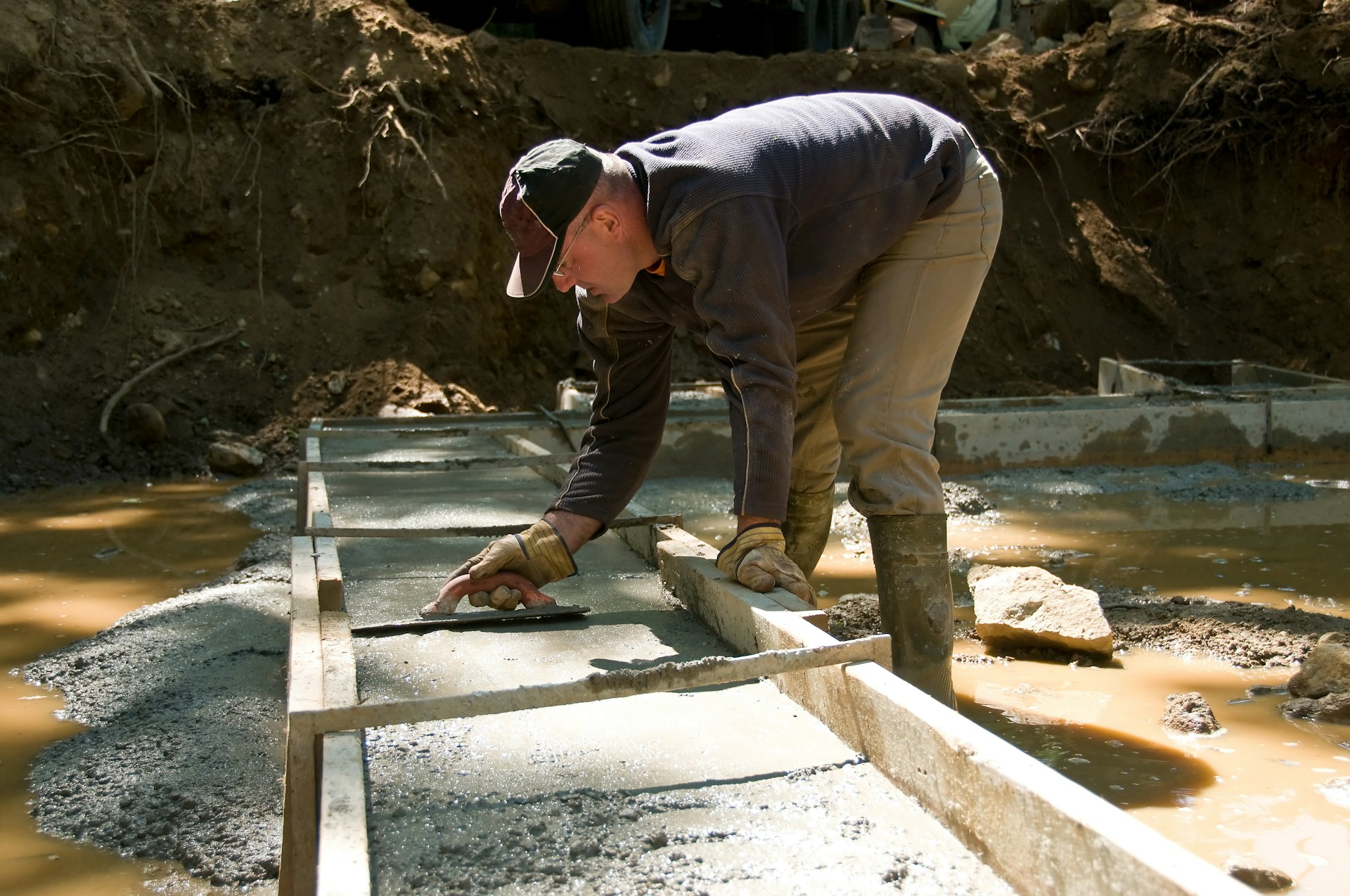Selling your home means making sure everything is in good shape, and that starts with a strong, stable foundation.
A home foundation checklist before selling helps you spot problems early, avoid costly last-minute repairs, and keep your sale moving forward without delays.
Foundation concerns can scare off buyers or lower your home’s value, but you don’t have to face them alone. Knowing what to check and when to act gives you more control and peace of mind during the selling process.
At Helicon, we’ve helped thousands of Florida homeowners fix foundation problems with permanent solutions that boost resale value and reduce stress during inspections.
In this blog, we will talk about:
- What to inspect before listing your home
- How to identify and handle foundation-related red flags
- Steps to protect your home’s value and avoid surprises
Let’s walk through the checklist that can make your sale smoother and your foundation stronger.
Why a Home Foundation Checklist Matters?
Using a foundation checklist before selling your home helps you catch problems early, speed up the sale process, and set a fair price. It ensures buyers feel confident, avoids surprises during closing, and clearly shows your home’s value based on its condition.
Increase Buyer Confidence
When you provide a clear foundation checklist, buyers know you’ve taken the time to inspect and address potential issues. This builds trust and shows you care about safety and long-term stability.
Buyers often worry foundation problems will lead to expensive repairs. Showing a detailed inspection report or completed repairs puts their mind at ease.
It also helps prevent them from walking away or offering low bids due to fear of hidden damage. Being open about your home’s foundation status can make buyers more comfortable moving forward. This confidence can lead to quicker offers and fewer negotiations over repairs.
Avoid Unexpected Delays
Foundation problems can cause major delays when selling a house.
Buyers will likely order their own inspections, which can uncover issues you didn’t know about. Having a checklist ready means you find and fix these problems up front. This preparation reduces the chances of surprises during inspection or appraisal.
By addressing foundation concerns early, you avoid last-minute requests for repairs or price drops. This keeps your sale on track and helps close the deal faster.
Support Fair Pricing
Foundation issues affect your home’s market value, sometimes lowering it depending on repair needs and severity.
You need to price your property based on facts, not guesswork. A checklist lets you identify current conditions and estimate repair costs. This information helps you set a fair price that reflects your home’s true value.
Overpricing can scare buyers away, while underpricing might cost you money. Use your foundation details to justify the asking price and show transparency.
Initial Foundation Inspection
Before listing your home, it’s important to look carefully at key areas that might show early signs of foundation problems. You’ll want to check the foundation itself, look for uneven floors, and inspect walls and ceilings closely for movement.
Look for Visible Cracks
Start outside by scanning your foundation walls, walkways, and driveway for cracks.
Small hairline cracks might be normal, but wider cracks—especially those that are stair-step-shaped or wider than 1/4 inch—can indicate foundation movement.
Inside, look around doors and windows. Cracks near these areas often mean the foundation is shifting. Mark the cracks and watch if they grow over a few weeks. Use a flashlight in dark corners and check the basement or crawl space carefully.
Cracks combined with moisture or rust can mean more serious damage.
Check for Uneven Floors
Walk through your home slowly to feel if any floors seem sloped, sagging, or uneven.
You can also roll a small ball on hard floors; if it rolls on its own, that could be a sign the foundation is off level. Look for gaps where floors meet walls or cabinets. Loose floorboards, squeaking, or gaps can also be clues.
Uneven floors may be caused by soil settling under your home or foundation shifts. These changes affect how your house feels and can affect resale value.
Inspect Walls and Ceilings for Signs of Movement
Look for cracks in interior walls and ceilings, especially around corners, windows, and doors.
Horizontal cracks near the foundation or wider-than-normal cracks can mean your walls are moving due to foundation issues. Check for walls that lean inward or outward. Also, watch for doors and windows that stick or don’t close properly, which can indicate frame movement.
Peeling paint or bulging drywall might also mean moisture or foundation stresses affecting your walls. Take pictures of damage to share with your inspector or contractor.
Moisture and Water Management
Managing water and moisture near your foundation is key to keeping your home stable and preventing costly problems. Paying attention to how water flows around your house, watching for leaks or damp spots, and keeping gutters working well will help protect your foundation from damage.
Assess Drainage Around Foundation
Check the soil and landscape near your foundation to ensure water moves away from your home.
The ground should slope downward, slanting at least 6 inches within the first 10 feet. Avoid flat areas that allow water to pool close to your walls. Look for clogged or broken drainage pipes, as these can cause water buildup.
Keep flower beds and mulch away from the foundation to stop water from soaking in too much. Fixing drainage issues early prevents water from weakening the soil and foundation over time.
Examine for Signs of Water Intrusion
Look carefully inside crawl spaces, basements, and around foundation walls for signs of water entering your home.
Search for stains, mold, mildew, or a musty smell. Cracks with moisture or water pooling on floors are red flags. Touch walls and floors to sense dampness, especially after heavy rain.
Even small leaks or moisture can cause serious damage if left untreated. Early detection lets you take action before problems become expensive repairs or affect your home’s value.
Evaluate Gutter and Downspout Condition
Gutters and downspouts direct rainwater away from your foundation, so they need to be clean and in good shape.
Check for cracks, holes, or sagging sections that can cause leaks or overflow. Make sure downspouts extend at least 5 feet from the foundation to carry water far enough away. Clean gutters at least twice a year to prevent blockages caused by leaves and debris.
Well-maintained gutters reduce water damage risk and improve overall foundation health.
Addressing Structural Issues
Before you sell your home, it’s important to understand what foundation problems you have and what needs fixing. This helps you prepare your home for inspection and makes the sale smoother. You’ll need to get a professional opinion, know which issues are serious, and decide what repairs are required.
Hire a Professional Inspector
Start by hiring a licensed foundation inspector.
A professional has the tools and experience to spot hidden problems you might miss. We will check for cracks, uneven floors, water damage, and soil movement around your home. Make sure the inspector gives you a detailed report.
This report helps you understand the severity of any issues and is useful when you disclose foundation conditions to potential buyers. A thorough inspection also helps you avoid surprises during the sale and can save you from costly last-minute repairs.
Identify Serious Foundation Problems
Not all foundation issues are the same. Some cracks or minor settling might be normal, but others signal serious problems that affect your home’s safety and value.
Look out for these signs:
- Large cracks wider than 1/4 inch in foundation walls or floors
- Doors and windows that stick or don’t close properly
- Uneven or sloped floors
- Gaps between walls and floors or ceilings
If you notice these problems, it’s important to act quickly. Serious structural damage can lower the home’s value and scare off buyers unless repaired or clearly disclosed.
Determine Necessary Repairs
Once problems are identified, figure out which repairs are needed before selling. Some repairs are simple, like filling small cracks or sealing foundations, while others are more involved.
Common permanent solutions include:
- Foundation Repair for cracks and shifting foundations
- Concrete Lifting to raise sinking slabs without major construction
- Soil Stabilization to secure the ground under your home, especially in Florida’s soft soils
You may choose to fix problems before selling, or sell “as-is” with full disclosure. Both options need planning. Repairs can boost your home’s value and buyer confidence, but you should weigh costs against potential sale price increases.
Documentation and Disclosures
When getting your home ready to sell, having the right documents and clear disclosures about your foundation is essential. This helps you avoid surprises later and builds trust with buyers. Being organized with repairs and honest about your foundation’s condition protects you legally and speeds up the sale.
Gather Repair Receipts and Reports
Collect all paperwork related to any foundation work done on your home. This includes repair invoices, inspection reports, and warranties.
These documents show buyers and their lenders that the foundational issue has been addressed professionally. If you had services like foundation repair, concrete lifting, or soil stabilization completed, keep detailed receipts.
Include dates, company names, and descriptions of work done. This proof makes your home more appealing and supports your asking price. Make sure to have any engineering or inspection reports on hand. They provide an honest look at the current foundation condition and any risks involved.
Keep these documents organized and ready to share when asked.
Prepare Disclosure Statements
You are legally required to disclose any known foundation problems when selling your home.
A disclosure statement lists defects or repairs related to the foundation. It helps buyers make an informed decision and avoids future legal issues. Be clear and detailed in your disclosure.
Mention issues like cracks, sinking floors, or past repairs. Include whether repairs were permanent solutions or temporary fixes. If you’re unsure what to disclose, check your local real estate laws or ask your agent. Disclosures should be truthful and complete.
Avoid hiding problems or downplaying their severity. Transparency builds trust and shows you prioritize a fair transaction. Keep your disclosure documents updated and easily accessible during the sales process.
Pre-Sale Foundation Maintenance
Focusing on your foundation before selling your home can help avoid costly repairs and improve buyer confidence. Simple maintenance steps can protect your home’s structure and add value without a major overhaul.
Seal Minor Foundation Cracks
Small cracks in your foundation might seem harmless, but they can cause bigger problems over time. Sealing these cracks helps prevent water damage and soil erosion, which can weaken your home’s base.
To seal minor cracks:
- Clean the area around the crack to remove dirt and debris.
- Use a high-quality epoxy or polyurethane sealant designed for foundation repairs.
- Apply the sealant carefully to fill the gap completely.
Sealing cracks yourself can save money, but if you see large or widening cracks, it’s best to get a professional inspection. Taking care of small cracks now helps maintain your home’s stability and can make inspections smoother during the sale process.
Improve Landscaping for Drainage
Proper drainage near your foundation is key to preventing water damage and soil shifting. If water pools around your home, it can weaken the ground and lead to foundation problems.
You can improve drainage by:
- Grading the soil so it slopes away from your foundation by at least 6 inches over 10 feet.
- Installing or cleaning gutters and downspouts to direct water far from your home.
- Using gravel or other drainage materials near the foundation to reduce moisture buildup.
Good landscaping prevents water from collecting near your foundation, keeping the structure strong and lowering the chance of costly fixes after you sell. It also gives a positive first impression to buyers concerned about foundation health.
Preparing for Buyer Inspections
Getting your foundation ready for buyer inspections means clearing the area around your home’s base and making sure any repairs are easy to see. These steps help the inspection go smoothly and show buyers that you care about your property’s condition.
Clean Around Foundation Perimeter
Start by removing leaves, dirt, and debris from around your foundation’s perimeter. This gives inspectors clear access to check for cracks, water damage, or soil issues.
Make sure grass and plants are trimmed back at least a few feet from the foundation walls. Also, check for standing water or drainage problems near the foundation. Fixing these can stop erosion or sinking issues before the inspection.
Clean gutters and downspouts so water flows away from your home, protecting the soil and foundation stability.
Highlight Recent Repairs
If you’ve fixed foundation issues recently, make them easy to find during the inspection.
Point out areas where cracks were sealed, piers were installed, or soil was stabilized. Providing documentation or receipts can back up your work. You might also want to expose repaired areas by clearing away dirt or repainting patch spots.
Letting the inspector see repairs clearly builds trust. It proves you’ve taken action to keep your foundation healthy.
Consult With Your Real Estate Agent
Talk closely with your real estate agent about your foundation’s condition.
Share any inspection reports or repair work you’ve completed. Your agent can help highlight these details in the listing to reassure buyers. They will also guide you on which repairs are necessary before listing.
Some issues might need fixing to prevent sale delays or price cuts later. Additionally, your agent can recommend specialists like home inspectors or foundation experts to give a final review.
Our advice can help you avoid common mistakes and streamline your sale.
Price Based on Foundation Condition
Set your home’s price with foundation condition in mind.
If you’ve done repairs or improvements, make sure the added value reflects in your asking price. If the foundation has minor issues that you haven’t repaired, consider a price adjustment. Buyers will factor in repair costs.
Use a pricing table like this to weigh your options:
| Foundation Condition | Pricing Suggestion |
|---|---|
| Recently repaired | Price at or slightly above market |
| Minor, disclosed issues | Slightly below market |
| Major or unknown problems | Significantly below market |
Pricing fairly based on foundation status shows transparency.
What Buyers Look for in a Home’s Foundation Report?
If you’re planning to sell a home with a history of foundation issues (or repairs), one document can make or break buyer confidence, your foundation report. Buyers and their agents will review this closely to assess long-term stability and risk. Knowing what they look for helps you prepare, answer questions confidently, and avoid delays during negotiation.
Here’s a table breaking down the key components buyers expect in a well-documented foundation report:
| Component | Why It Matters to Buyers |
| Professional Inspection Summary | Shows the issue was properly assessed by a qualified expert. |
| Scope of Work Completed | Details the exact repairs performed, helping buyers understand the severity and resolution. |
| Warranty Information | Adds trust and reduces perceived risk; buyers love transferable warranties. |
| Engineer’s Certification (if any) | Adds credibility, especially for major structural work. |
| Before-and-After Photos | Visual proof of damage and repair quality; builds transparency. |
| Soil and Drainage Notes | Indicates if environmental factors were addressed, not just symptoms. |
| Monitoring Recommendations | Helps buyers understand any future steps required, if applicable. |
Wrapping It Up
Preparing your home’s foundation before selling isn’t just about avoiding surprises, it’s about building trust and showing buyers your property is truly cared for.
A well‑kept foundation boosts buyer confidence, helps you justify your asking price, and keeps the sale process moving smoothly.
By inspecting early, addressing small issues, and keeping documentation ready, you set yourself apart from other sellers and reduce the stress of negotiations. Whether it’s sealing minor cracks, improving drainage, or gathering repair records, these steps show buyers you value transparency and quality.
Ready to make sure your foundation passes every buyer’s inspection?
Contact Helicon today to schedule a professional foundation assessment and give your home the solid start it deserves on the market.
Frequently Asked Questions
Before selling your home, foundation issues can raise a lot of questions, especially if you’re unsure what buyers or inspectors might flag. Here are some quick, helpful answers to give you more clarity and confidence.
Can minor foundation cracks affect the home sale?
Yes, even small cracks can raise red flags. Buyers may ask for repairs or price reductions, especially if cracks appear near doors or windows. It’s best to get them evaluated and documented professionally before listing.
Is it okay to sell a house with previous foundation repairs?
Absolutely. Just make sure you have repair records, warranties, and proof of professional work. Transparency builds buyer trust and shows that the issue has been responsibly addressed.
How soon should I schedule a foundation inspection before listing?
Ideally, schedule it 1–2 months before putting your home on the market. This gives you time to plan any repairs, get quotes, and avoid last-minute surprises during the buyer’s inspection.
Will insurance cover any pre-sale foundation repairs?
Not usually. Most home insurance policies don’t cover foundation issues caused by settling, age, or poor construction. Coverage may apply only in specific cases like storm damage or plumbing-related erosion; check your policy to be sure.
Can landscaping affect my foundation’s resale appeal?
Yes! Overgrown roots or improper drainage near the foundation can raise concerns. Trim back trees, clear gutters, and redirect water flow away from the home to prevent inspection issues tied to landscaping.





